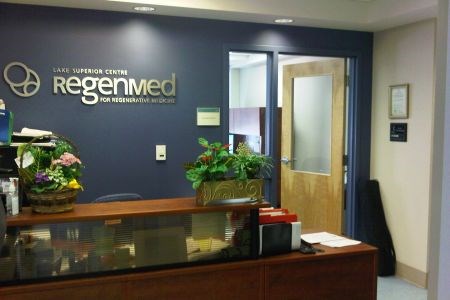There are brighter days ahead for a Thunder Bay tissue bank now armed with a long-overdue provincial designation.
It should breathe new life into the Lake Superior Centre for Regenerative Medicine – commonly know as Regen Med – which was on the brink of closing the doors at its Munro Street facility.
The designation by the Ministry of Health and the Trillium Gift of Life Network will allow the not-for-profit company to retrieve and process tissue and bone from Ontario donors for the first time.
Obtaining it was crucial to Regen Med's survival, which began operations in November 2007. Without it, “it would've been tough,” said interim CEO Bob Thayer.
“The focus now is on putting us in a position where we are going to be recovering Canadian donors and processing that tissue to get it out to Ontario hospitals.”
Thayer said Regen Med is in a strong position to grow and meet the need of Ontarians with freeze-dried tissue.
It could also mean adding to their seven-person staff, said Thayer.
“Within a year, we could have 25 people potentially.”
Regen Med is considered to be one of the cornerstone companies in Thunder Bay's growing health and life sciences innovation cluster.
For most of its short four-year history, it had agreements with tissue banks in the U.S. and Manitoba to distribute allografts to 20 hospitals and dentists in Ontario.
An allograft is a tissue transplant from one person to another who are not identical twins.
Though the company held U.S. and international accreditation, they could not retrieve and process tissue and bone from Ontario donors, even from the local hospital, Thunder Bay Regional Health Sciences Centre.
With state-of-the-art lypophilization (freeze-drying) equipment and highly trained staff, it was a wasted opportunity for the company and Ontario donors.
The facility is capable of processing up to 200 donors annually. Without the Ontario designation, the staff were handling one or two donors per month.
It ran contrary to the original mission statement to provide Canadian surgeons with a reliable supply of processed tissue.
Adding to its struggles, Regen Med is a totally independent institution, not affiliated with any hospital. There was also a business partnership with LifeNet Health, a Virginia-based tissue bank that fell apart in 2009.
Early on, Regen Med management decided not to pursue an Ontario designation. But when the company lured Thayer out of retirement last December, he pushed for it.
“We had to get it. We had no choice,” said Thayer, who credits local MPPs Michael Gravelle and Bill Mauro for their assistance in securing the designation through the Ministry of Health.
Thayer is well known locally as the former president of Genesis Genomics (now known as Mitomics), a local health biotech company and is considered a pioneer in the city's life sciences research sector.
He explalined there's a growing shortage of bone and tissue for procedures like hip replacements, a concern that surfaced in a recent Auditor General of Ontario's report because of an aging population.
About $19 million leaves Ontario every year because most of the tissue supplied to provincial hospitals comes from the U.S.
With demand only expected to escalate, it's feared those U.S. sources will dry up.
Thayer said they are making arrangements this spring to start receiving donors from the local hospital by early May.
“I'm anticipating we will increase the number of donors exponentially in Thunder Bay and are working on agreements with other facilities to provide us with donor tissue for us to process.
“It's realistic to think that this year, we could be doing between 25 to 40 donors.”
The anticipated growth curve could have Regen Med looking to expand within, or beyond, their current digs inside the ICR Discoveries building, a renovated former cancer hospital in the city's north end.
Building an R&D lab is very much alive as part of a second phase of expansion, if they build up the donor volume and generate substantial income, said Thayer.




